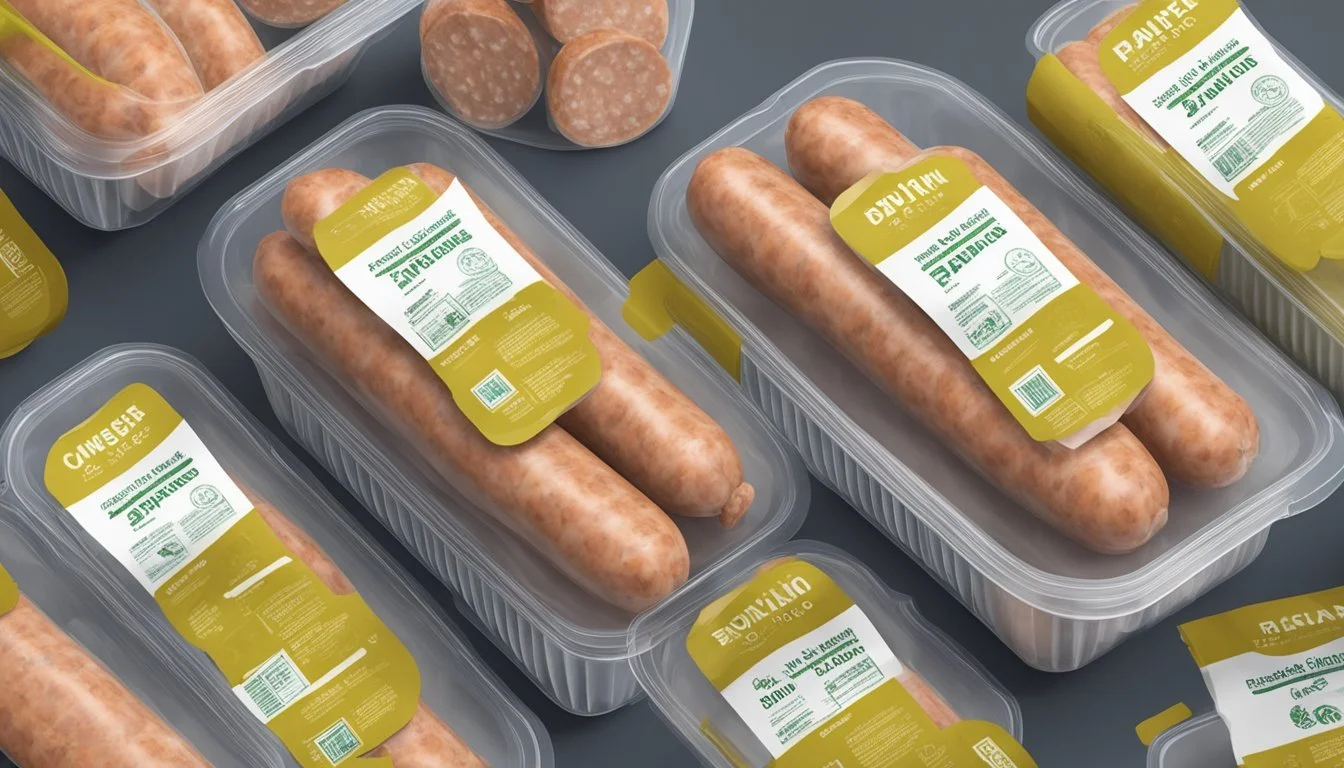How Long Do Plant-Based Sausages Last?
Shelf Life and Storage Tips
Plant-based sausages, as a vegan alternative to traditional meat products, cater to a diverse consumer base that adheres to plant-based diets for varied reasons including health, ethical, and environmental concerns. Understanding how long these vegan-friendly items last is crucial for maintaining both their taste and nutritional value, as well as ensuring food safety. Unopened plant-based sausages can generally be stored in the refrigerator for up to two weeks, ensuring they remain fresh and suitable for consumption.
Once the packaging is opened, the shelf-life of plant-based sausages decreases. To maximize freshness and maintain quality, it is recommended to consume these sausages within a week of opening. When transferring them to the freezer, the sausages can remain at peak quality for several months, which makes freezing an excellent option for extending their usability over time. It is important to note that, regardless of being stored in the fridge or freezer, the appearance of mold indicates spoilage, and such products should be discarded immediately.
Understanding Plant-Based Sausages
In the realm of plant-based diets, sausages made from non-animal sources have become a staple. They provide a familiar texture and flavour for those seeking to reduce or eliminate meat consumption.
Defining Plant-Based Meat Alternatives
Plant-based meat alternatives, such as vegan sausages, serve as a substitute for traditional meat sausages. They are designed to mimic the taste, texture, and nutritional value of meat while being made from plants. Unlike their meat counterparts, they are cholesterol-free and often lower in saturated fat.
Types of Vegan Sausages
The market offers a myriad of vegan sausages, each with its own unique blend of ingredients and spices. Some common categories of vegan sausages include:
Classic/Traditional: Designed to taste like familiar pork or beef sausages.
Specialty Flavour: These can include a variety of spices and flavor profiles, from spicy to herb-infused.
Ethnic Varieties: Mimic sausages from different cuisines, such as Italian or Chorizo-style.
Protein Sources in Plant-Based Sausages
Plant-based sausages acquire their protein content from a number of sources, which include:
Soy Protein: Derived from soybeans, it's a complete protein offering all essential amino acids.
Pea Protein: A gluten-free alternative that is rich in iron and used in many plant-based meat products.
Wheat Gluten (Seitan): Offers a chewy texture, although it's not suitable for those with gluten intolerances.
Nuts and beans may also be utilized for their protein content and texture. They are often combined with vegetables and various spices to enhance flavor and nutritional profile. Vegan sausages aim to offer a high-protein, satisfying option for vegan meat enthusiasts.
Storage Fundamentals
Maintaining the quality and extending the shelf life of plant-based sausages depend on proper storage methods and conditions. This section will outline the essential practices for optimal preservation.
Optimal Storage Conditions
To ensure the freshness and safety of plant-based sausages, they should be stored in a refrigerator at a constant temperature of 4°C (39°F) or lower. An airtight container is ideal to protect the sausages from moisture and other contaminants. The right storage conditions prevent the growth of bacteria and maintain the product's quality.
Proper Refrigeration:
Temperature: Keep at 4°C (39°F) or below
Container: Use an airtight container for extra protection
Unopened vs Opened Packaging
The shelf life of plant-based sausages can vary significantly between unopened and opened packages.
Unopened Packages:
Refrigerator: 1-2 weeks
Freezer: Up to 6 months for best quality
Note: Always check the product's expiration date as a primary guideline.
Opened Packages:
Refrigerator: Consume within 3-4 days
Use an airtight container to maintain freshness after opening
Freezing opened sausages is possible but may affect texture upon thawing
By adhering to these fundamental storage practices, consumers can enjoy their plant-based sausages while maximizing their shelf life and ensuring their meal remains a healthy choice.
Shelf Life of Plant-Based Sausages
The shelf life of plant-based sausages largely depends on storage conditions such as refrigeration and the use of preservatives. Proper storage ensures the maintenance of freshness and extends the usable life of the product.
Refrigeration and Freshness
When stored in the fridge, unopened plant-based sausages can remain fresh for up to two weeks. Once opened, they should be consumed within a week to ensure best quality. The fridge temperature affects the shelf life, and it is advisable to keep the sausages in the coldest part of the refrigerator, typically at or below 40°F (4°C).
Freezing and Extended Preservation
Freezing offers a way to significantly extend the shelf life of plant-based sausages. When stored in the freezer at 0°F (-18°C) or below, sausages can last for up to six months without compromising quality. For optimal freezing, one should:
Place sausages in a freezer-safe container or bag.
Remove as much air as possible before sealing.
Label the container with the freeze date to monitor the use-by date.
Impact of Preservatives
Preservatives play a critical role in prolonging the shelf life of plant-based sausages. Manufacturers may add natural or synthetic preservatives to inhibit microbial growth and prevent spoilage. The presence of such preservatives can extend the expiration date, but it remains essential to adhere to the use-by date provided on packaging and look for visible signs of spoilage, such as mold or an off-odor, regardless of the date specified.
Safe Handling and Preparation
Taking the right steps during safe handling and preparation is critical for maintaining the quality of plant-based sausages and ensuring safety. Key practices include adhering to proper cooking methods and understanding the rules of thawing and refreezing.
Cooking Methods
Plant-based sausages can be prepared similarly to meat sausages but might require less cooking time. Here are specific cooking methods:
Frying Pan: Heat a non-stick pan and add a small amount of oil. Cook the sausages over medium heat, turning them regularly until evenly browned and heated through.
Grilling: When grilling, lightly oil the sausages and cook them on a medium-hot grill, rotating to achieve an even cook. They should develop a crisp outer skin and reach a hot internal temperature.
Plant-based sausages usually do not contain the same levels of fat as meat and hence can dry out or stick if not cooked carefully. They should never be eaten raw and need to reach a safe internal temperature, much like their meat counterparts.
Thawing and Refreezing Rules
For plant-based sausages that have been previously frozen and need thawing:
Thawing: Ideally, thaw sausages in the refrigerator to ensure they remain at a safe temperature throughout the process.
Refreezing: It's not recommended to refreeze plant-based sausages after they've been thawed, as the process can affect their taste and texture.
When handling frozen products, one should minimize the time they spend at room temperature to prevent bacterial growth and potential foodborne illness. If the sausages have been left to thaw outside for more than two hours, or one hour in temperatures above 90°F (32°C), they should be cooked immediately or discarded.
Health and Nutrition
When considering plant-based sausages, one examines both their nutritional value and how they compare to traditional animal-based sausages. These factors are crucial for consumers focusing on a healthy and nutritious vegan diet.
Nutritional Benefits
Plant-based sausages serve as a beneficial part of a vegan diet, often rich in protein, fiber, and essential vitamins. While their exact nutritional content can vary by brand and ingredients, they typically offer a substantial amount of protein per serving. For example, a single serving might meet nearly half of the daily protein recommendation. This protein usually comes from sources such as soy, peas, and other legumes, which are recognized for their health benefits.
Protein: Essential for muscle repair and growth.
Fiber: Aids in digestion and promotes a feeling of fullness.
Vitamins: Many are fortified with vitamins such as B12, which is crucial for those on a vegan diet.
The inclusion of other nutritious ingredients like vegetables contributes additional vitamins and minerals, enhancing the overall dietary value. However, consumers should be aware of the sodium content, which can be high in some plant-based sausages, to manage their overall sodium intake effectively.
Comparing to Animal-Based Sausages
Compared to their meat counterparts, plant-based sausages generally contain less saturated fat and cholesterol, making them a heart-healthier option. They are designed to offer a similar taste and texture experience while also providing certain nutritional benefits inherent to a plant-based diet.
Saturated Fat: Often lower in plant-based options.
Cholesterol: Plant-based sausages contain no cholesterol.
Moreover, for those individuals with dietary restrictions or ethical concerns about animal products, plant-based sausages offer a nutritious alternative that aligns with their needs without significantly compromising on nutrition or taste.
Enjoying Plant-Based Sausages
Plant-based sausages offer a versatile and flavorful protein option for various meals. They can be incorporated into creative recipes and paired with a range of accompaniments to enhance their taste.
Creative Recipe Ideas
Recipe innovation with plant-based sausages is vast, catering to vegan and vegetarian diets. For a hearty breakfast, one might slice and sauté vegan sausages to add to a tofu scramble, infusing the dish with herbs such as thyme or turmeric for extra flavor. For meal prep, incorporating vegetarian sausages into a lentil stew can offer a comforting and nutritious option, particularly when added with a bouquet of aromatic herbs like rosemary or bay leaves. Here are two specific recipes:
Lentil and Plant-based Sausage Stew:
Cook lentils as per package instructions.
Sauté sliced vegetarian sausages until browned.
Combine with cooked lentils, diced tomatoes, and a mixture of herbs and spices.
Simmer for 20 minutes until flavors meld.
Vegan Sausage Pasta:
Cook pasta al dente, set aside.
In a separate pan, brown sliced vegan sausages.
Add a sauce made from tomatoes, garlic, basil, and oregano.
Toss with pasta and serve hot.
Accompaniments and Pairings
The right accompaniments can take a simple plant-based sausage meal to the next level. Breakfast sausages might pair well with a side of roasted breakfast potatoes seasoned with paprika and garlic powder. For a lunch or dinner scenario, one could serve grilled vegan sausages atop a bed of rice, possibly a fragrant basmati or wild rice, giving a satisfying texture contrast. Below is a brief pairing guide:
Meal Time Accompaniment Seasoning Breakfast Roasted Breakfast Potatoes Paprika, Garlic Lunch Grilled Sausages with Rice Herbs de Provence Dinner Pasta with Vegan Sausage Sauce Basil, Oregano
To conclude, when enjoyed as part of a varied diet, plant-based sausages can be both a delicious and healthful addition to one's culinary repertoire.







